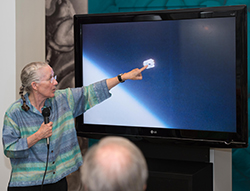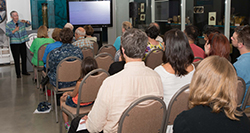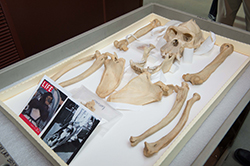Space travel just like winter camping, according to former astronaut
By Paul Bello, National Museum of Health and Medicine
SILVER SPRING, Md. - The idea of traveling to space is a dream for many, but for Dr. Mary Cleave, it's a memory that will last a lifetime. A former NASA astronaut, Cleave experienced the euphoria of space travel twice in her career and was delighted to look back on one of those missions during her presentation, 172 Orbits Around the Earth, at the National Museum of Health and Medicine's (NMHM) monthly Medical Museum Science Café, held June 23 at its location in Silver Spring, Maryland.
Cleave joined the astronaut corps in May 1980 while working as a research engineer for the Utah Water Research Laboratory at Utah State University. Five years later, she was assigned the role of mission specialist aboard space shuttle Atlantis for mission STS-61-B. The shuttle launch, which marked the second night launch in the history of NASA's space shuttle program, occurred on Nov. 26, 1985. It was Atlantis' second mission, having just completed its maiden voyage into space nearly two months earlier.
"You're on your back with your feet up in the air. Surprisingly, the shuttle doesn't really take off that fast," Cleave said while the official NASA video of the mission played in the background. "I was a flight engineer during this flight, so I was busy watching data and monitoring our instruments. A great ride it was."
At night upon separation from the solid rocket motors, the shuttle becomes enveloped in a ball of flame as it makes its way into orbit. Once in space, Cleave said the shuttle turns into an orbit vehicle. There are checklists that astronauts use to adjust the vehicle so that it becomes a space station before turning back into a descent vehicle for the journey home.
At first an astronaut's body needs to adapt to the loss of gravity, according to Cleave. She lost her appetite as her digestive tract shut down for a period of time. It started back up in the middle of the first night on orbit with her stomach growling and her appetite returning. There is also a fluid shift to the upper body with the lack of gravity to pull the fluids down. This makes for skinny legs and puffy faces, Cleave continued.
During this particular mission, Cleave and her fellow astronauts deployed three communications satellites, while also conducting experiments in assembling large structures in space. When it was time for two of her colleagues to conduct their planned spacewalks, it was Cleave who was operating the shuttle's robotic arm and watching their every move quite cautiously.
"The controls operating the robotic arm are just like flying a spacecraft on orbit. It has two hand controllers and what we call six degrees of freedom. But, as we found out, that can actually be a problem," Cleave said. "There are mathematical solutions where you don't know what direction it's going to go. It will hesitate a bit and if you have someone on the other end of the arm that is next to a big structure, you have to make sure you don't squash him or her. As a result, the robotic arm on the space station was designed to have seven degrees of freedom, not six."
Since there's no gravity in space, Cleave said astronauts maneuver through the shuttle by diving through a hole on the floor in order to get to its mid deck. While astronauts don't have a lot of spare time, she remembers spending as much time as she could looking out the shuttle's main window. While there are too many memories to count from her first mission, having Thanksgiving dinner in space is certainly high on the list.
"It was the one meal we could all have together. We had turkey with gravy, instant mashed potatoes, Ocean Spray cranberry sauce and some bread," Cleave recalls. "My fellow astronaut Jerry Ross decided to eat dinner while sitting on the ceiling of the shuttle. He said it would be the only time he'd ever get to do that in life. And he did."
Sleeping on orbit is different. Astronauts can float around inside a sleeping bag so they don't float away and wake up on an air intake. Though, Cleave said its helps to remember to put your hands in your pockets so they don't float up and hit your face.
On the way home, astronauts sit in the middle of what Cleave refers to as a physics class. The shuttle fired over the coast of China coming back across the Pacific Ocean for its scheduled landing at Edwards Air Force Base in California. Shuttle commander Brewster Shaw Jr. guided Atlantis in for such a smooth landing that Cleave recalls hearing the wheels rolling on the runway before feeling any pressure.
"During reentry your brain recognizes that you are back in a gravity field. It's like there is a little switch that goes off saying, ‘OK so this is gravity again,' and you start compensating for it," Cleave said. "It does take a little time to relearn to manage the momentum of your weight."
After seven days in space, Cleave was happy to be home and really looking forward to a shower. There's no shower in space, so she said astronauts resort to sponge baths. She did suffer some bone loss during the flight, as astronauts were not taking measures to combat bone loss in the early days of the shuttle program.
Cleave returned to space aboard Atlantis four years later during a mission that saw the launching of the Magellan spacecraft that would later travel to Venus. This flight was close to solar max and so the radiation exposure was higher. She said astronauts have a higher cancer rate similar to people that work at high altitudes
"Going to space in a shuttle is just like winter camping," Cleave said. "It's a lot of fun."
Coinciding with Cleave's presentation was a temporary display of the skeletal remains of Ham, the first chimpanzee launched into space. Ham flew aboard the Mercury-Redstone 2 flight on Jan. 31, 1961. The success of that mission is what directly led to the launch of astronaut Alan Shepherd's first human suborbital flight in May that same year.
NMHM's Medical Museum Science Cafés are a regular series of informal talks that connect the mission of the Department of Defense museum with the public. NMHM was founded as the Army Medical Museum in 1862 and moved to its current location in Silver Spring, Md. in 2012. For more information, visit www.medicalmuseum.mil.

|
Caption:
Dr. Mary Cleave, former NASA astronaut and associate science administrator, was guest speaker at the National Museum of Health and Medicine's monthly Medical Museum Science Café, held June 23, 2015.
(Disclosure: This image has been cropped to emphasize the subject.) (National Museum of Health and Medicine photo by Matthew Breitbart / Released) |

|
Caption:
Dr. Mary Cleave, former NASA astronaut and associate science administrator, was guest speaker at the National Museum of Health and Medicine's monthly Medical Museum Science Café, held June 23, 2015.
(Disclosure: This image has been cropped to emphasize the subject.) (National Museum of Health and Medicine photo by Matthew Breitbart / Released) |

|
Caption:
The space chimp Ham was on display during the Medical Museum Science Café at the National Museum of Health and Medicine June 23, 2015. Ham's flight led directly to astronaut Alan Shepherd's first human suborbital flight in May 1961.
(Disclosure: This image has been cropped to emphasize the subject.) (National Museum of Health and Medicine photo by Matthew Breitbart / Released) |



